KCSE Past Papers Biology 2011
2.1.1 Biology Paper 1 (231/1)
1 Name two kidney diseases. (2 marks)
2 (a) Write the dental formula of an adult human. (1 mark)
(b) Name two dental diseases. (2 marks)
3 Give three reasons for classifying organisms. (3 marks)
4 State one use for each of the following apparatus in the study of living organisms. (a) Pooter.(1 mark)
5 The figure below illustrates a food web in a certain ecosystem.
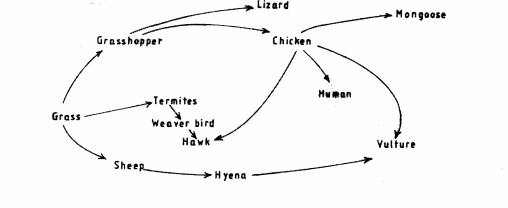
From the food web:
(a) draw the shortest food chain;(1 mark)
(b) identify the organisms with the highest (1 mark)
(i) number of predators;(1 mark)
(ii) biomass.(1 mark)
6 What is meant by the following terms‘?
(:1) Ecology.(1 mark)
(b) Carrying capacity.(1 mark)
7 The diagrams below show an experimental set-up to investigate a certain process in a plant tissue.
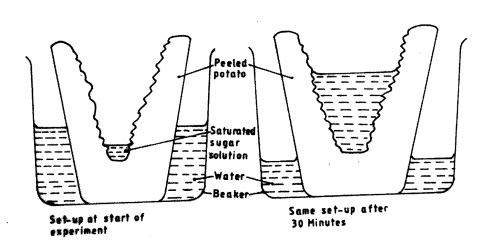
Explain the results obtained after 30 minutes.(4 marks)
8 State three characteristics of the class crustacea.(3 marks)
9 The diagrams below illustrate the organs of some flowering plants.
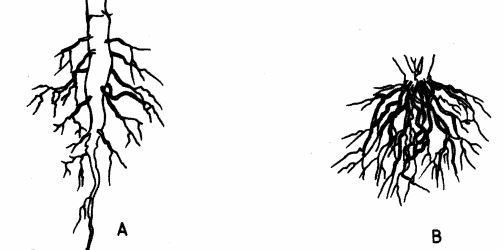
State the classes of plants to which each belong. (2 marks)
A ………………………..
B……………………… ..
10 (a) Give two differences in the products of anaerobic respiration between plants and animals. (2 marks)
(b) Name the site of anaerobic respiration in a cell. (1 mark)
11 State the functions of the following parts of a light microscope.
Fine adjustment knob.
Stage. (2 marks)
12 The diagram below represents a certain organism.(2 marks)

State the phylum and class to which it belongs.
Phylum …………………..
Class ………………….(2 marks)
13 State two functions of carbohydrates in the human body.(2 mark)
14 The diagram below represents a certain plant.

(a) What is the likely habitat for the plant?(1 mark)
(b) Give two reasons for your answer in (a) above.(2 marks)
15 Give reasons for carrying out the following procedures when preparing temporary wet mounts of plant tissues.
(a) Making thin plant sections.(1 mark)
(b) Adding water on the plant section.(1 mark)
(c) Placing a cover slip over the plant section.(1 mark)
16 (a) Describe the condition known as varicose veins.(2 marks)
(b) What is the role of blood platelets in the blood clotting process?(2 marks)
17 The diagram below represents part of the human digestive system.

(a) Name the organs labelled L and M. (2 marks)
L……………………..
M …………………….
(b) (i) Name the substance produced by the organ labelled K. (1 mark)
(ii) State the function of the substance named in b(i) above. (l mark)
18 (a) Name one salivary gland in humans. (1 mark)
(b) State two functions of saliva. (2 marks)
19 Apart from the lungs, name two gaseous exchange surfaces in a frog. (2 marks)
(b) Write an equation that summarizes the process of aerobic respiration. (1 mark)
20 The number of stomata on the lower and upper surfaces of two leaves from plant species X and Y were counted under the field of view of a light microscope. The results were as shown in the table below.

(a) Which of the two leaves would be expected to have a lower rate of transpiration? (1 mark)
(b) Give a reason for your answer in (a) above. (1 mark)
21 (a) What is meant by convergent evolution? (l mark)
(b) State two limitations of fossils as an evidence of evolution. (2 marks)
22 State the difference in content of oxygen and carbon (IV) oxide in the air that enters and leaves the human lungs. (2 marks)
23 The diagram below represents a transverse section of an ovary from a certain flower.

(a) (i) Name the structure labelled W. (1 mark)
(ii) Name the type of placentation illustrated in this diagram. ( 1 mark)
24 (a) Differentiate between the following terms:
(i) dominant gene and recessive gene; (1 mark)
(ii) continuous variation and discontinuous variation. (1 mark)
(b) What would be the expected results from a test cross? (2 marks)
25 State one economic importance of each of the following plant excretory products.
(a) Tannin.
(b) Quinine.
(c) Caffeine.
26 Name the gamete cells that are produced by the ovaries.(1 mark)
27 The diagram below represents features of a joint in a mammal.

(a) Name the part labelled A.(1 mark)
(b) State the function of the part labelled B. (1 mark)
28 (a) What is a tropic response? (1 mark)
(b) State two ways by which auxins regulate growth in seedlings. (2 marks)
29 State four reasons why water is significant in seed germination. (4 marks)
(a) Give an example of a plant whose flowers have the type of placentation named in (a)(ii) above. (1 mark)
2.11 Biology Paper 2 (231/2)
SECTION A (40 marks)
Answer all the questions in this section in the spaces provided.
1 The set-up below illustrates a procedure that was carried out in the laboratory with a leaf plucked from a green plant that had been growing in sunlight.
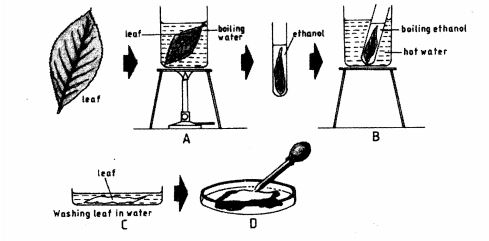
(i) What was the purpose of the above procedure? (1 mark)
(ii) Give reasons for carrying out steps A, B and C in this procedure. (3 marks)
A ………………………..
B …………………………
C …………………………
(iii) Name the reagent that was used at the step labelled D. (1 mark)
(iv) State the expected result on the leaf after adding the reagent named in (iii) above. (1 mark)
2 In humans, hairy ears is controlled by a gene on the Y Chromosome.
(a) Using letter Y“ to represent the chromosome carrying the gene for hairy ears, work out a cross between a hairy cared man and his wife. (4 marks)
(b) (i) What is the probability of the girls having hairy ears? (1 mark)
(ii) Give a reason for your answer in (b(i) above. (1 mark)
(c) Name two disorders in humans that are determined by sex-linked genes. (2 marks)
(d) Explain how comparative embryology is an evidence for organic evolution. (2 marks)
3 (a) Name the causative agents for the following respiratory diseases. (2 marks)
(i) Whooping cough.
(ii) Pneumonia.
(b) Describe how oxygen in the alveolus reaches the red blood cells. (4 marks)
(c) How are the pneumatophores adapted to their function? (2 marks)
4 (a) The diagram below represents a section of the human brain.
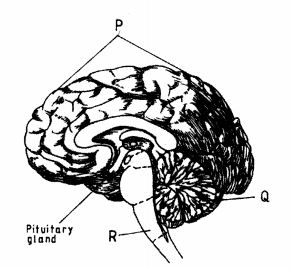
(i) Name the structures labelled P and R. (2 marks)
P ……………………………
R …………………………..
(ii) State two functions of the part labelled Q. (2 marks)
(b) (i) Name two reproductive hormone secreted by pituitary glands in women (2 marks)
(ii) state the function of each of the hormones named in (b)(i) above (2 marks)
5 (a) The diagram below represents a flower

(i) On the diagram, name two structures where meiosis occurs. (2 marks)
(ii) How is the flower adapted to prevent self-pollination? (2 marks)
(b) The diagram below represents a human reproductive organ.
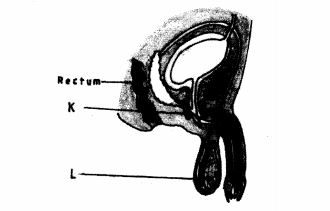
(i)Explain two adaptations of the structure labelled L to its functions. (2 marks)
2 arks) (ii) Explain the role of the gland labelled K.(2 marks)
SECTION B (40 marks)
Answer question 6 (compulsory) and either question 7 or 8 in the spaces provided after question 8.
6 (a) An experiment was carried out to investigate the population of a certain micro-organism. Two petri-dishes were used. Into the petri-dish labelled M. 60cm3 of a culture medium was placed while 3()cm3 of the same culture medium was placed in petri-dish labelled N. Equal numbers of the micro-organisms were introduced in both petri-dishes. The set-ups were then incubated at 35°C. The number of micro-organisms in each petri-di sh was determined at irregular intervals for a period of 60 hours. The results were as shown in the table below.

(i) On the same axes, draw the graphs of relative number of micro-organisms against time on the grid provided. (7 marks)
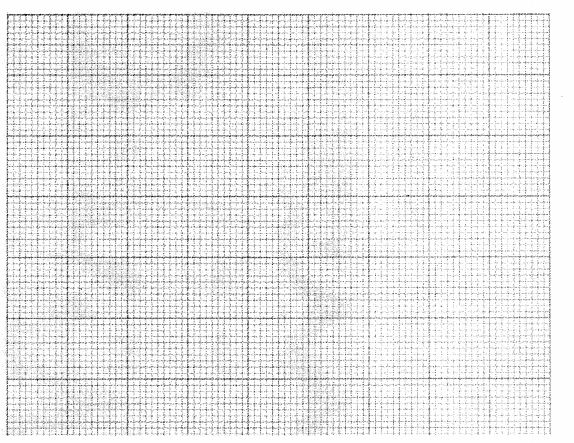
(ii) After how many hours was the difference between the two populations greatest? (1 mark)
(iii) Work out the difference between the two populations at 50 hours. (2 marks)
(iv) With a reason state the effect on the population of micro-organisms in petri-dish M if the temperature was raised to 60°C after 20 hours. (2 marks)
(v) Account for the shape of the curve for population in petri-di sh N between 46 hours and 59 hours. (3 marks)
(b) Explain how the osmotic pressure in the human blood is maintained at normal level. (5 marks)
7 (a) Explain how structural features in terrestrial plants affect their rate of transpiration.(13 marks)
(b) Explain how the human skin brings about cooling of the body on a hot day. (7 marks)
8 (a) Describe the exoskeleton and its functions in insects. (13 marks)
(b) Describe how accommodation in the human eye is brought about when focusing on a near object. (7 marks)
1.1.3 Biology Paper 3 (231/3)
1 Below is a photograph of a fish‘ Examine it and answer the questions that follow.
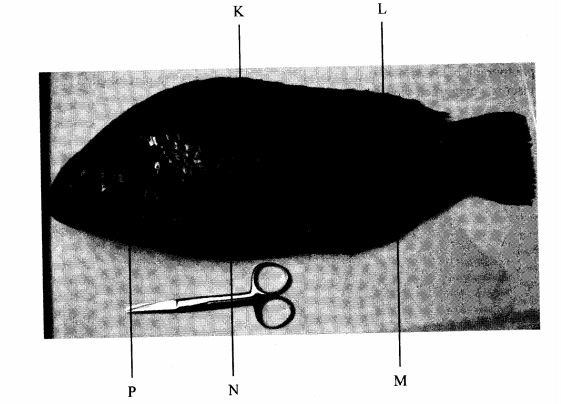
(a) Name the parts labelled K, L , M and N, (4 marks)
K …………….
L …………..
M ………….
N …………..
(b) The actual length of the pair of scissors next to the fish is 12.5cm. Using this information, calculate the actual length of the fish. (3 marks)
(c) Name the fins that prevent the following movements of fish during swimming (3 marks)
(i) Yawing: …………………………
(ii) Pitching: …………………… .. and …. …………………. …
(c) Name the fins that prevent the following movements of fish during swimming.
(3 marks)
(i) Yawing: ………………………….
(ii) Pitching: ………………………… .. and ………………….
(d) The photograph below shows structures visible alter removing the part labelled P. The inset is a magnified view of one of the structures.
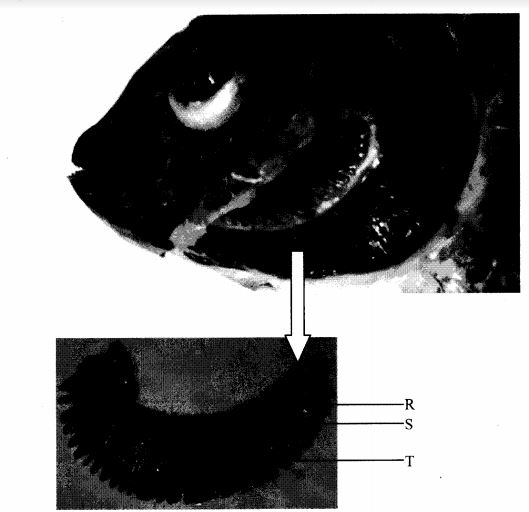
(i) Name the parts labelled R, S and T. (3 marks)
R ………………………………… ..
S …………………………………..
T …………………………………..
(ii) Explain how each of the pans named in (d) (i) above is adapted to its function. (3 marks)
2 The photographs labelled D and E show two types of leaves.
PHOTOGRAPH D
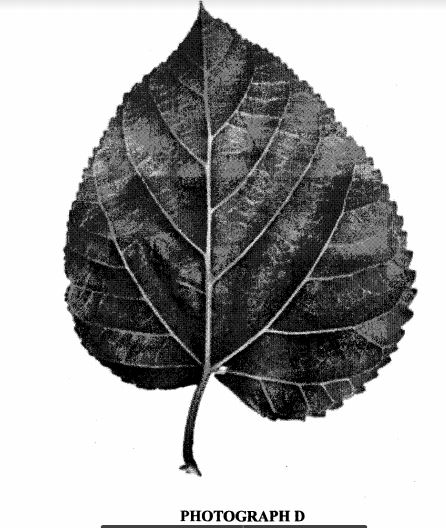
PHOTOGRAPH E
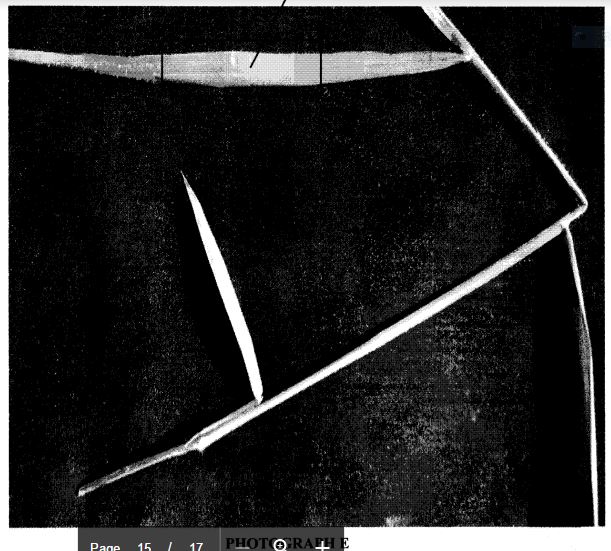
(a) With a reason, state the classes of plants from which the leaves in Photographs D and E were obtained. (4 marks)
Photograph D
Reason
Photograph E
Reason
(b) State three features in the leaf shown in photograph D that adapt it to its functions. (3 marks)
(c) The photographs below show the structures observed in cross sections of parts of two types of plants as seen under a light microscope.
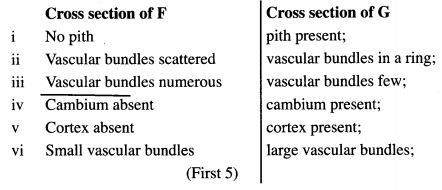
(i) Name the part labeled U, V and W
(ii) Identify five differences between cross sections F and G and record them in the table below. (5 marks)
Cross Section F 1 Cross Section G
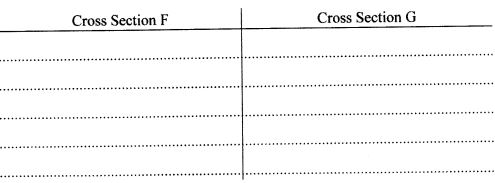
3 You are provided with a sample of food labelled X in solution form, solution J (Iodine solution).
solution K (Benedict’s solution) and solution L (Biuret’s reagent). Carry out tests on the food sample to identify the type of food substances present. (9 marks)
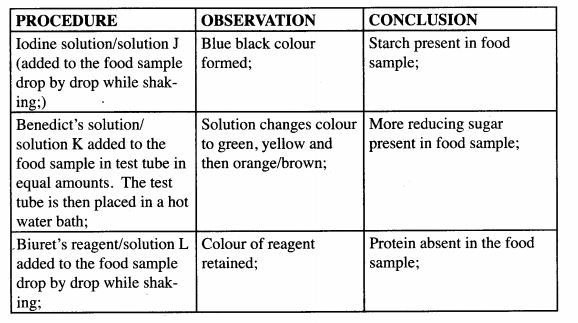
2011 KCSE Biology Past Paper-Marking Scheme/Answers
1 (i) Nephritis;
(ii) kidney stones; (2 marks)
2 (a) equatioon
(b)Dental carries;
Periodontal/gingivitis/pyorhoea; (2 marks)
3(i) Identify similarities and differences between organisms;
(ii) Organize scientific knowledge in an orderly system;
(iii) Monitor emergence, presence and disappearance of organisms in and from the earth;
(iv) Grouping organisms for easy study;(3 marks)
4 (a) Sucking small insects/animals; (1 mark)
(b) A trap into which small animals fall and get trapped; (1 mark)
5 (a)

(b) (i) Chicken;
(ii) Grass; (2 marks)
6 (a)This is the study of the inter-relationship between organisms and their environment; (1 mark)
(b) The maximum population of a species than a particular habitat can support; Without depletion of resources.(1 Mark)
7 Water was hypotonic to cell sap of adjacent cells;
and these cells absorbed water through osmosis;
and their cell sap became less concentrated than those of the next cells;
The process was repeated until water reached the sugar solution; (4 marks)
8 Fused head and thorax/cephalothorax often protected by a carapace;
Gaseous exchange through gills;
Two pairs of antennae;
Five to twenty pairs of limbs;
A pair of compound eyes;
Three pairs of mouth parts (consisting of mandibles, maxillary, palp and labium) a pair of mandibles and 2 pairs of maxillae.(3 marks)
9 (a) Dicotyledonae; (1 mark)
(b) Monocotyledonae; (1 mark)
10 (i) Lactic acid in animals while in plants it is ethanol/alcohol;
(ii) No carbon IV oxide produced in anaerobic respiration in animals while anaerobic respiration in plants produces carbon IV oxide; (2 marks)
11. Moves the body tube through smaller distances to bring the image/specimen/object into sharper focus;Platform where specimen (on slide) is placed;(2 marks)
12. Chordata; ‘ Aves;(2 marks)
13. Source of energy; Storage materials;(2 marks)
14. (a) Dry/Arid/Semi-arid/Desert;
(b) Succulent/fleshy stem; reduced leaves/
leaves reduced into thoms/leaves modified into spines/spikes;(1 mark)
15. (a) To reduce layers of cells to allow light to pass through;
(b) To make the cells turgid/prevent drying up;
(c) To protect the lens on the objective;
16. (a) Weakened/defective valves in veins; causing blood/body fluid to accumulate; leading to swelling. (2 marks)
(b) When exposed to air they disintegrate/rupture/burst; releasing thromboplastin; thrombokinase (2 marks)
17.(a) L – Duodenum;
M – Pancreas; (2 marks)
(b) i) Bile;
(ii) Emulsification/emulsifies fats;
(iii) Provides alkalinic medium for enzyme action.
(iv) Neutralizes acidic chyme. (2 marks)
18. (a) Sublingual gland; submaxillary gland; parotid gland; submandibular First one (1 mark)
(b) Lubricating food; digestion of starch; moisten food; provide alkaline medium; First two (2 marks)
19. (a) (i) Skin; (ii) buccal cavity/mouth cavity (2 marks)
(b)

20. (a) X; (1 mark)
(b) X has fewer stomata; most stomata in leaf X are concentrated on the lower side; Any one (1 mark)
21. (a) Where different structures evolve to perform the same function (e .g. wings of insects and birds are different in structure but are used for flying);(1 mark)
(b) Missing links;
Distortion of parts during sedimentation/earthquakes/putrefication;
Destruction of fossils by geological activities/faulting/folding;
First two (2 marks)
22. Air that enters lungs has a higher content ofoxygen than air that leaves the lungs; Air that enters the lungs has lower content of carbon (IV) oxide than air that leaves the lungs;(2 marks)
23. (a) (i) Ovule; (1 mark)
(ii) Axile placentation; (1 mark)
(b) Orange or any correctly named citrus plant; » (1 mark)
24. (a) (i) Dominant gene expresses itself phenotypically in both its homozygous and heterozygous states while recessive gene can only express itself phenotypicallj in the homozygous state; (1 mark)
(ii) Continuous variation is a characteristic for which there is a continuum or rang: while discontinuous variation is a characteristic for which there are discrete categories or units; (1 mark)
(b) Either all offspring show the dominant characteristics;
or half offspring show the recessive while the other half show the dominant characteristics; (2 marks)
25. (a) Softening of leather; (1 mark)
(b) Treatment of malaria/manufacture of antimalaria drugs.; (1 mark)
(c) Stimulant used in beverages; (1 mark)
26. egg/ovum/ova; (1 mark)
27. (a) Ligament; (1 mark)
(b) Secretes synovial fluid; contains/holds the synovial fluid in place; any one (1 mark)v 28. (a) It is a growth movement in plants in response to a unidirectional stimulus; (1 mark)
(b) Accelerates growth of shoots;
Can inhibit growth of roots;(2 mark)
29. Activate enzymes; provides a medium for enzymatic activities to break down stored food to soluble form; Hydrolyses; dissolves food materials; is a medium of transportation of dissolve food substances to growing regions of radicle and plumule; Softens seed coat to facilitate emergence of radicle; First four (4 marks)
9.2 Biology Paper 2 (231/2)
1. (i) – Testing a leaf for the presence of starch;
(ii) – A – kill the leaf/break down cells/stop enzymatic activity;
B – Removal of chlorophyll;
C – Soften leaf/makes leaf less brittle;
(iii) Iodine solution;
(iv) Areas where starch is present stain blue/blue black; Total(6 marks)
2.(a)
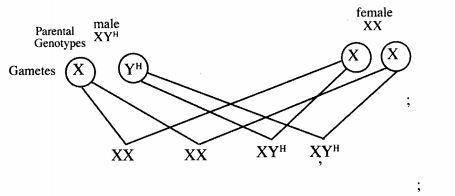
(b)(i) Probability of girls having hairy ears is zero ‘O’ ;
(ii) The gene for hairy ears is on the Y chromosomes which girls do not inherit from their father; (2 marks)
(c) Haemophilia; Colour blindness; (2 marks)
(d) Vertebrate embryos have similar morphological features; which suggest a common ancestry; (2 marks)
3 (a) (i) Bordetella pertussis
(ii) Streptococcus pneumoniae
(iii) micoplasma pheumonia
(b) Inhaled oxygen dissolves in moisture in the alveolus; since the oxygen concentration in blood is lower; than in the alveolus, oxygen diffuses; through the alveolus epithelium, the capillary wall into the plasma; and finally into the red blood cells.
(4 marks)
(c) Pneumatophores – grow into the air above mud/water; their lenticel for gaseous exchange; (2 marks)
4 (a) (i) P – is cerebral hemisphere/cerebrum;
R – medulla oblongata; (2 marks)
(ii) Muscular co-ordination; maintaining body posture; manual /motar dexterity;
(first two)
(2 marks)
(b) (i) Follicle stimulation hormone; luteinizing hormone; oxytocin; prolactin;
(first two)
(2 marks)
(ii) FSH – stimulates secretion of oestrogen; stimulates development of the Graafian follicle;
LH – Brings about ovulation; causes development of corpus luteum;
Oxytocin – causes contraction of uterus; causes expulsion of milk from mammary glands;
Prolactin – stimulates milk production/secretion; (2 marks)Total (8 marks)
5- (a) (i) Anthers; Ovary; (2 marks)
(ii) Anthers are below the stigma to minimize self pollination;
– petals are large/conspicuous, for insects to land on/ to attract insects encouraging cross pollination;
– presence of interstitial cells that secrete androgens. (2 marks)
(b) (i) L is hanging outside the body to ensure optimal temperature for sperm production; it has many, long and coiled seminiferous tubules to increase the surface area for production/storage of sperms; (2 marks)
(ii) K produces an alkaline fluid that neutralizes acid in the vagina; this fluid contain nutrients for the sperms; and also activates sperms; (2 marks)
Total (8 marks)
6. (a) (i) See graph. (7 marks)
(ii) 42 hours; (1 mark)
(iii) Graph M at 50 hrs is 1220 i 20.
Graph N at 50 hrs is 540 1 20 (2 marks)
1220 – 540 = 680 1 4;
(iv) Population growth stops;
High temperatures kill the microorganisms/denature enzymes; (2 marks)
(v) 46 hours to 59 hours death rate of the microorganisms is higher, than their population growth rate; due to exhaustion of nutrients; and accumulation of toxic wastes; (3 marks)
(b) When the osmotic pressure of the blood increases beyond the normal level the hypothalamus detects this and stimulates the pituitary gland; to secrete more ADH; hormone which make kidney tubules more permeable to water; and more Water is re-absorbed into the blood; reducing the osmotic pressure to the normal level.; (accept the reverse description) (5 marks)
Total (20 marks)
7. (a) Plants in arid, semi-arid and desert habitats have leaves covered with thick/waxy cuticles; that are waterproof/impermeable to water; allowing for reduced rate of transpiration; Sunken stomata; in some desert/semi arid areas plants have water va; accumulating in the pits; reducing rate of transpiration (as the moisture in the pit is i carried away by wind.)
Most plants have few or no stomata on the upper surface of leaf; the fewer the stomata the less the water lost from the plant. Some plants have small stomata/stomatal size decrease when guard cells are flaccid; thus reducing transpiration rate.
Plants with small/folding leaves; expose less surface area; hence reduce the rate of transpiration. Leaves with shinny surfaces; reflect light resulting reduced leaf temperatures; thus reducing the rate of transpiration.
Some plants have leaves covered with hairs/scales; which trap a layer of moisture; c the leaf surface reducing rate of transpiration.
Mesophyte have a thin layer of cuticle; to facilitate high transpiration rate; brad lenses exposing large area to transpiration; Many stomata on both leaf surfaces provide many apartunes to enhance transpiration. (13 marks)
(b) Erector pilli muscle relax; and hair lie fiat; trapping less air; thus reducing insulation; Blood capillaries under the skin vasodilate; and more blood is brought under the skin; increasing heat loss; sweat glands release more sweat to the skin surface; the sweat take away heat from the body when it evaporates; (9 marks)
(7 maximum)
8 (a)The exoskeleton is made of chitin; chitin is not evenly distributed; hence it allows for movement; exoskeleton is secreted by the epidermal cells; when still soft it allows for growth of the insect; when in contact with the air it hardens limiting growth; lt is shed regularly; thus regulating the growth of insects. It also supports the internal structures; Because it is hard; it protects; internal organs from mechanical damage. It is water proof; preventing water loss/dessication; of the insect. It also provides a surface for attachment of muscles; _ (13 marks)
(b) Light rays from a near object are more diverged and need to bend more; in order to be focused properly on the retina; ciliary muscles contract; suspensory ligaments attached to the ciliary muscles relax; the lens becomes thicker; increasing its curvature/becomes more convex; light from the object is refracted more; in order to be focused/more sharply on the retina to form an image.
(7 marks)
Biology Paper 3 (231/3)
1 (a)K – Pectoral fin;
L- Dorsal fin;
M- Anal fin;
N- Pelvic fin;
(4 marks)
(b) The size of scissors on the photograph is 4.6
The length of fish on the photograph is 13.6 ;
Mg = Image length
Actual length
Actual length of fish is imageeeeeeee
(c) (i) Yawing – Dorsal fin;
(ii) Pitching – Pectoral fin; Pelvic fin; (3 marks)
(d) (i) R – gill rakers;
S – gill bar;
T — gill filaments; (3 marks)
(ii) R — sharp/numerous/pointed/arranged closely in a row to trap solid
that can damage the filaments;
S – rigid/firm to hold gill filaments in place;
T – numerous to increase surface area for gaseous exchange/thin
to reduce the distance for gaseous exchange/vascularized to
transport respiratory gases away from the respiratory surface/
moist to dissolve oxygen for diffusion;
(3 marks)
(Total = 16 marks):
2 (a) Leaf D – class dicotyledonae;
Reason – network of veins/presence of petiole;
Leaf E – class monocotyledonae;
Reason – parallel venation/presence of leaf sheath;
(4 marks):
(b) Broad and flat to offer a large surface area for photosynthesis;
Thin to reduce distance over which carbon IV oxide diffuses to reach the mesophyll cells;
Rich supply of veins to transport water to photosynthetic cells;
Presence of chlorophyll to absorb light for photosynthesis; (first 3 = 3 marks)
(c) (i) U- xylem;
V – phloem;
W – cambium;
(ii)Cross section of F

3

Award marks for correct procedure, observation and conclusion only. (9 marks)

